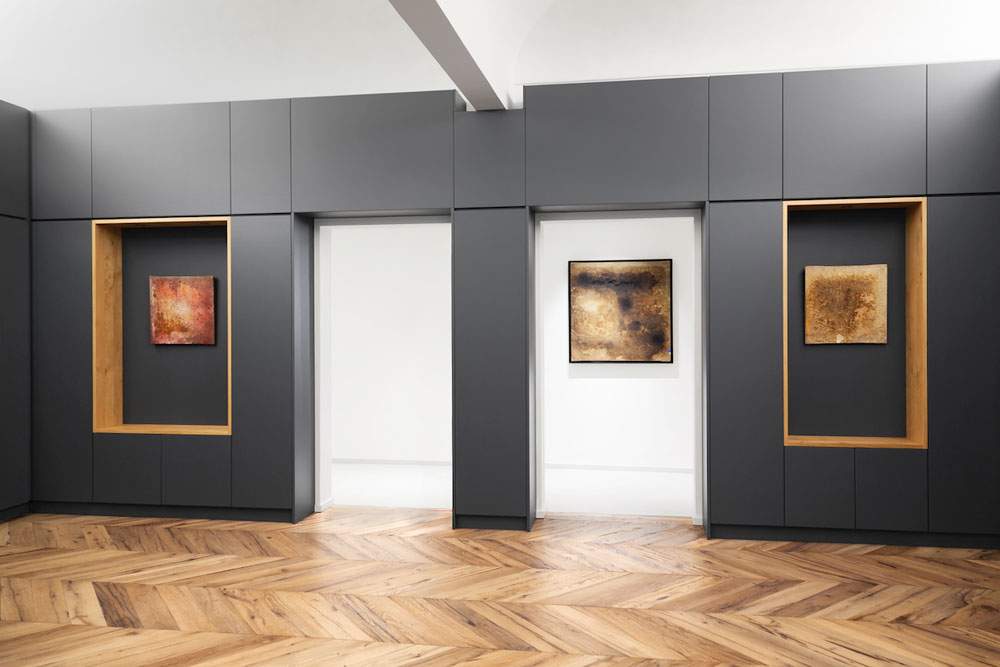The exhibition Invisible Flowers by the duo TTOZOI, curated by Sabino Maria Frassà, is on view at Gaggenau DesignElementi in Rome from July 5 to November 12, 2021.
A central concept of the exhibition is the drama caused by thelife-death ambivalence of nature: on display are artworks made from organic materials, such as flour, water and natural pigments, which originate molds. The duo TTOZOI, composed of Stefano Forgione (Avellino, 1969) and Giuseppe Rossi (Naples, 1972), created paintings through the use of mold, which is usually considered the enemy of art and synonymous with something gone bad. To arrive at this result, the artists went through a long process invisible to the eyes, strongly influenced by and in connection with environmental conditions.
“Nature is the greatest artist. Artists are the directors of the work of art, because the real protagonist and painter remains nature itself, which imperiously manifests itself on the canvases in all its inimitable complexity and unrepeatability,” explains curator Sabino Maria Frassà. “Therefore, although TTOZOI start from postwar informal art, the inspiration from American abstractionism and Mark Rothko’s tension to infinity is clear. Theirs is a process art in which the artistic gesture, in an exquisitely maieutic sense, complements and guides nature in self-manifestation: on reflection, we can even say that the paintings largely self-determine and that an epiphany of nature takes place with them. Artists ’merely’ determine the conditions for life to depart, flourish and leave its mark on the canvases. Man, from being an enemy of nature, for once becomes a humble narrator of its beauty and intimate fragility.”
With organic materials (various flours), water and natural pigments on jute canvases, the TTOZOIs implement an “Art Area” consisting of various installations of sealed vitrines, inside which the canvases are placed and left here for about forty days. During period, time and nature act on these materials, favoring the conditions for the natural formation of mold on the canvas, with manifestations always different since they are conditioned by the external variables specific to the place of execution.
With Invisible Flowers, the Gaggenau DesignElements becomes a creative laboratory, where canvases made by TTOZOIs will mature into a true testament to the place where they were generated. The spores, in fact, interact with the works initiated by the artists, while the authors monitor the progression of the process and let the canvas capture the humus, the soul of the place. When they decide to interrupt it, the memory of life remains imprinted on the canvas: the artwork takes shape only when the vital process has been accomplished, and within the vitrines lies the story of a flowering as impetuous as it is now irretrievably past. Only at this point do artists intervene, “digging” into the remnants of what remains of this invisible flowering. “Since always and forever,” concludes curator Frassà, “every new life feeds more or less consciously on the traces of the past, which it assimilates and makes its own, in order to finally succeed in blooming into something unpredictably new. This is the magic of TTOZOI’s art: digging into invisibility to bring out the invisible flowers of yesterday, today and tomorrow.”
Invisible Flowers is part of the art cycle Extraordinary - Art and Design.
Hours July 5 to Nov. 12, 2021 (summer closure Aug. 9 to 31): Monday to Friday 10:30 a.m. to 1 p.m. and 3:30 to 7 p.m.
Photo credits: ©Francesca Piovesan - Courtesy TTOZOI, Gaggenau and Cramum.
 |
| When mold creates works of art: an exhibition in Rome by the duo TTOZOI |
Warning: the translation into English of the original Italian article was created using automatic tools. We undertake to review all articles, but we do not guarantee the total absence of inaccuracies in the translation due to the program. You can find the original by clicking on the ITA button. If you find any mistake,please contact us.